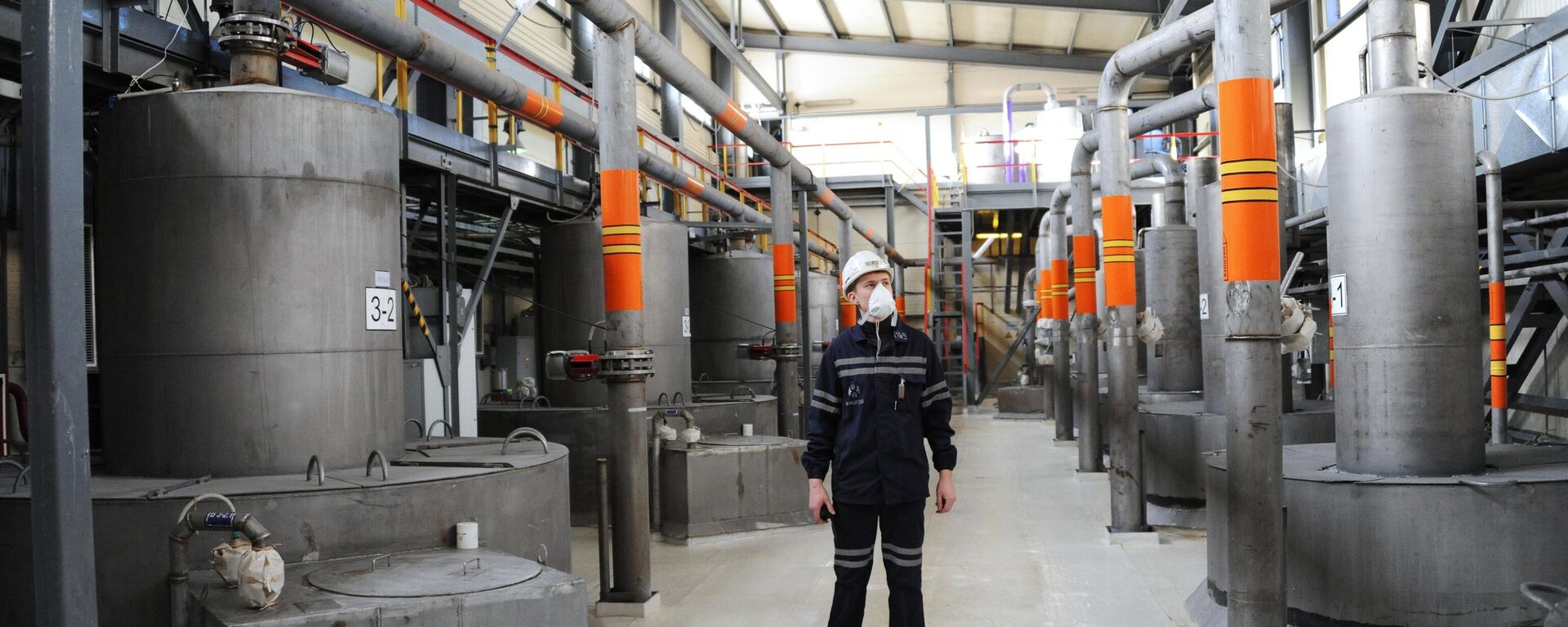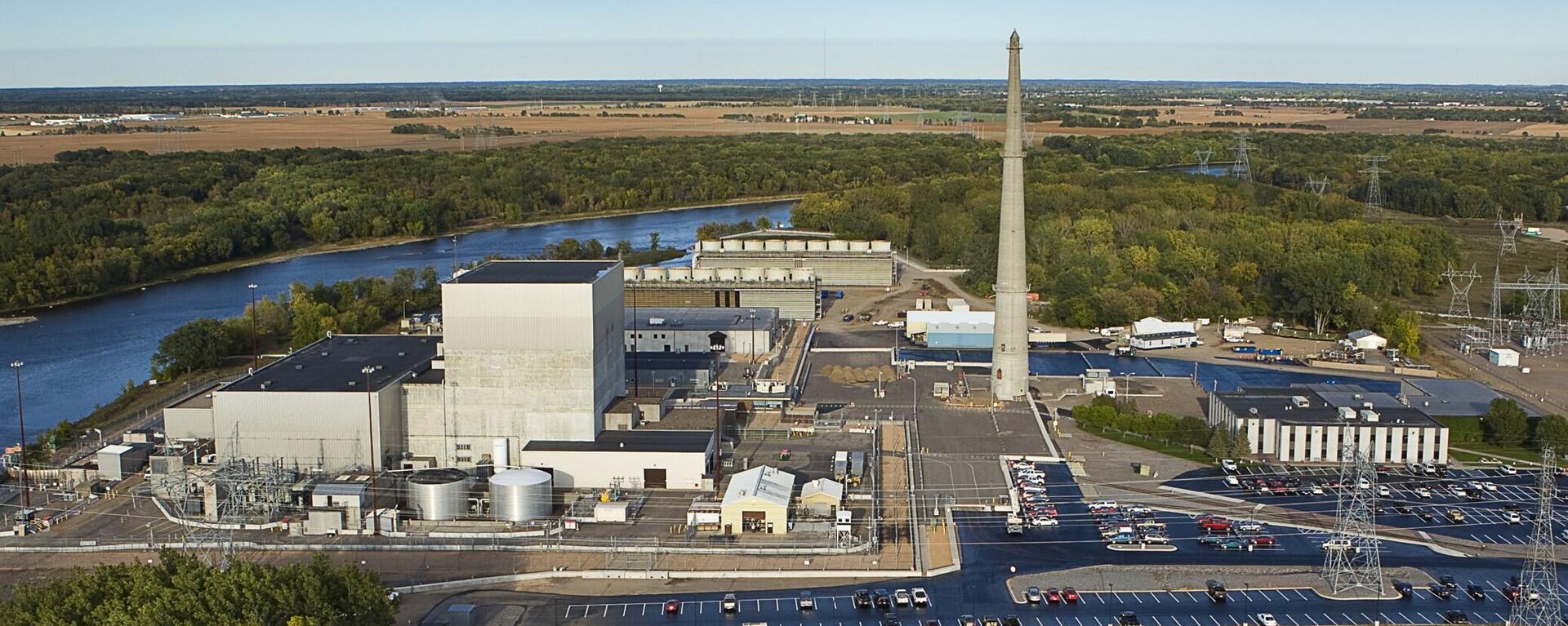https://sputnikglobe.com/20240812/russias-nuclear-reactor-construction-clout-could-nullify-effect-of-us-ban-on-its-uranium-1119735797.html
Russia's Nuclear Reactor Construction Clout Could Nullify Effect of US Ban on Its Uranium
Russia's Nuclear Reactor Construction Clout Could Nullify Effect of US Ban on Its Uranium
Sputnik International
The loophole contained in the US ban on enriched uranium imports from Russia 'can be attributed to purely economic rationale, Valeriy Menshikov, member of public council of “Rosatom” corporation, told Sputnik.
2024-08-12T16:35+0000
2024-08-12T16:35+0000
2024-08-12T16:35+0000
analysis
russia
uranium
uranium enrichment
nuclear power plant
us energy department
us sanctions
rosatom
https://cdn1.img.sputnikglobe.com/img/101803/63/1018036375_0:198:4739:2863_1920x0_80_0_0_a3bc22a2d35719164e8fdb6e1dba335d.jpg
The waiver loophole contained in the US 'Prohibiting Russian Uranium Imports Act' that has just come into force can be attributed to purely economic rationale, Valeriy Menshikov, member of public council of “Rosatom” corporation, member of Russia’ Council Centre for Ecological Policy told Sputnik.One consideration is that the Russian method of enriching uranium to be used as fuel for nuclear power plants is the most cost effective by all indicators, he pointed out. There exist two commercial uranium enrichment processes: gaseous diffusion and gas centrifugation. Both involve the use of uranium hexafluoride and produce enriched uranium oxide. The methods used by the US consume much more electric energy power, he added.Russia is the world's top supplier of enriched uranium. Its uranium enrichment plants account for up to 40% of the world’s enrichment capacity. Imports to the US surged to a record level of $1.2 billion-worth in 2023 (an increase of 40 percent compared to 2022). In the first quarter of 2024, the US purchased about 91 tons of enriched uranium from Russia, valued at $210 million, according to Comtrade data.Like the long list of previous sanctions slapped on Russia by the collective West, this ban has also been described as inherently self-harming by a plethora of experts. Valeriy Menshikov concurred, and weighed in on why waivers and loopholes in the uranium ban would be eagerly sought out.The average age of US commercial nuclear power reactors that were operational as of April 30, 2024, is around 42 years. There are 94 nuclear reactors across the country. According to the US Nuclear Regulatory Commission, 22 commercial nuclear power reactors at 18 sites were in various stages of decommissioning as of last year.Most of the operational ones belong to Gen 2, noted Menshikov, while the scale of energy production requires Gen 3 reactors, which are considered an evolutionary improvement.But the most important aspect here is that, unlike in Russia, almost all the commercial reactors in the US are owned by private companies, stressed the pundit. Generally, the American nuclear industry as a whole has far greater private participation than any other country.Of course, only time will show to what extent these US private companies will seek out loopholes in the ban on Russian enriched uranium, Menshikov noted. But for Russia this ban is not a big loss, since it is a global leader in the construction of nuclear power plants. “We are building in many countries in Asia, Turkiye, Egypt, India, Bangladesh, Hungary,” he emphasized, with preliminary discussions on the construction of small nuclear power plants underway in Africa, Latin America, and so on. Russia will have a very large amount of the necessary enriched uranium products for these facilities, noted the expert As for Russia’s alternatives in connection with the US ban, it’s enough to recall that in May China imported a record amount of Russian uranium worth $233 million. The Chinese market is huge, the expert added.Then there is also the issue of prices. “In general, any tense geopolitical situation in the world always results in an increase in the price of certain products, such as oil, gas, and, of course, such high-tech products as enriched uranium,” remarked Menshikov.As for the much-flaunted plans by Washington to shake off reliance on Russian enriched uranium supplies by boosting its own production, they will take a lot of time and investment. Menshikov recalled the way Joe Biden had bragged about a US facility having produced its first 90 kilograms of high-assay low-enriched uranium (HALEU) in April.“This simply makes me smile,” the pundit said, as “90 kilograms is nothing, almost zero” for the needs of the US.Everything from research centers to the required technology would need “at least 5-8, maybe 10 years,” Menshikov concluded.
https://sputnikglobe.com/20240514/us-ban-on-russian-uranium-imports-wont-fare-better-than-other-failed-western-sanctions--expert-1118425211.html
https://sputnikglobe.com/20240511/why-russian-uranium-ban-has-given-entire-us-nuclear-industry-the-shivers-1118389908.html
russia
Sputnik International
feedback@sputniknews.com
+74956456601
MIA „Rossiya Segodnya“
2024
News
en_EN
Sputnik International
feedback@sputniknews.com
+74956456601
MIA „Rossiya Segodnya“
Sputnik International
feedback@sputniknews.com
+74956456601
MIA „Rossiya Segodnya“
russian uranium export, loophole in us ban on enriched uranium imports from russia, waivers on russian uranium imports, can us do without russian enriched uranium, russian uranium ban, us banned russian enriched uranium, russian uranium ban will grant waivers through 2027, centrus energy stated it will apply for waiver to buy russian enriched uranium, low enriched uranium, rosatom, tenexus uranium imports, prohibiting russian uranium imports act, russian us energy cooperation
russian uranium export, loophole in us ban on enriched uranium imports from russia, waivers on russian uranium imports, can us do without russian enriched uranium, russian uranium ban, us banned russian enriched uranium, russian uranium ban will grant waivers through 2027, centrus energy stated it will apply for waiver to buy russian enriched uranium, low enriched uranium, rosatom, tenexus uranium imports, prohibiting russian uranium imports act, russian us energy cooperation
Russia's Nuclear Reactor Construction Clout Could Nullify Effect of US Ban on Its Uranium
A US ban on low-enriched uranium produced in the Russian Federation or by a Russian entity came into force on August 11 as part of the sanctions campaign against Moscow. It does, however, allow for some waivers issued by the US Energy Department until 2028.
The waiver loophole contained in the US '
Prohibiting Russian Uranium Imports Act' that
has just come into force can be attributed to purely economic rationale,
Valeriy Menshikov, member of public council of “
Rosatom” corporation, member of Russia’ Council Centre for Ecological Policy
told Sputnik.
One consideration is that the Russian method of
enriching uranium to be used as fuel for nuclear power plants is the most cost effective by all indicators, he pointed out. There exist two commercial uranium enrichment processes: gaseous diffusion and gas centrifugation. Both involve the use of uranium hexafluoride and produce enriched uranium oxide. The methods used by the US consume much more electric energy power, he added.
“Russia and Rosatom occupy this niche in the global technological space to about 40%. We rely on the most advanced method of enrichment using centrifuges. We have the ninth generation of centrifuges already operation at full capacity. However, US engineers have not been able to replicate this type of centrifuge that would ensure, a stable operation of the industry,” he said.
Russia is the world's top supplier of enriched uranium. Its uranium enrichment plants account for up to 40% of the world’s enrichment capacity. Imports to the US surged to a record level of $1.2 billion-worth in 2023 (an increase of 40 percent compared to 2022). In the first quarter of 2024, the US purchased about 91 tons of enriched uranium from Russia, valued at $210 million, according to Comtrade data.
US President Joe Biden signed into law H.R.1042, the Prohibiting Russian Uranium Imports Act, in mid-May. It went into force this month and bans any imported unirradiated low-enriched uranium (LEU) produced in the Russian Federation or by a Russian entity. Waivers are allowed in cases when the US determines that no alternative viable source of low-enriched uranium is available to sustain the continued operation of a US nuclear reactor or nuclear energy company, or if it also determines that importing the uranium is in the national interest.
Like the long list of
previous sanctions slapped on Russia by the collective West, this ban has also been described as inherently self-harming by
a plethora of experts. Valeriy Menshikov concurred, and weighed in on why waivers and loopholes in the uranium ban would be eagerly sought out.
The average age of US commercial nuclear power reactors that were operational as of April 30, 2024, is around 42 years. There are 94 nuclear reactors across the country. According to the US Nuclear Regulatory Commission, 22 commercial nuclear power reactors at 18 sites were in various stages of decommissioning as of last year.
Most of the operational ones belong to Gen 2, noted Menshikov, while the scale of energy production requires Gen 3 reactors, which are considered an evolutionary improvement.
But the most important aspect here is that, unlike in Russia, almost all the commercial reactors in the US are owned by private companies, stressed the pundit. Generally, the American nuclear industry as a whole has far greater private participation than any other country.
“And there they know the value of money, naturally. So that's why there's such a loophole, it's simply practical. Each company can, apparently, independently conclude certain contractual agreements with Rosatom. That's the most important thing,” said.
Of course, only time will show to what extent these US private companies will seek out loopholes in the ban on Russian enriched uranium, Menshikov noted. But for Russia this ban is not a big loss, since it is a global leader in the construction of nuclear power plants. “We are building in many countries in Asia, Turkiye, Egypt, India, Bangladesh, Hungary,” he emphasized, with preliminary discussions on the construction of small nuclear power plants underway in Africa, Latin America, and so on. Russia will have a very large amount of the necessary enriched uranium products for these facilities, noted the expert
As for Russia’s alternatives in connection with the US ban, it’s enough to recall that in May China imported a record amount of Russian uranium worth $233 million. The Chinese market is huge, the expert added.
Over 34 gigawatts (GW) of nuclear power capacity were added in China in the past 10 years, bringing the country's number of operating nuclear reactors to 55, with a total net capacity of 53.2 GW as of April 2024.
Then there is also the issue of prices. “In general, any tense geopolitical situation in the world always results in an increase in the price of certain products, such as oil, gas, and, of course, such high-tech products as enriched uranium,” remarked Menshikov.
As for the much-flaunted plans by Washington to shake off reliance on Russian enriched uranium supplies by boosting its own production, they will take a lot of time and investment. Menshikov recalled the way Joe Biden had bragged about a US facility having produced its first 90 kilograms of high-assay low-enriched uranium (HALEU) in April.
“This simply makes me smile,” the pundit said, as “90 kilograms is nothing, almost zero” for the needs of the US.
Everything from research centers to the required technology would need “at least 5-8, maybe 10 years,” Menshikov concluded.




